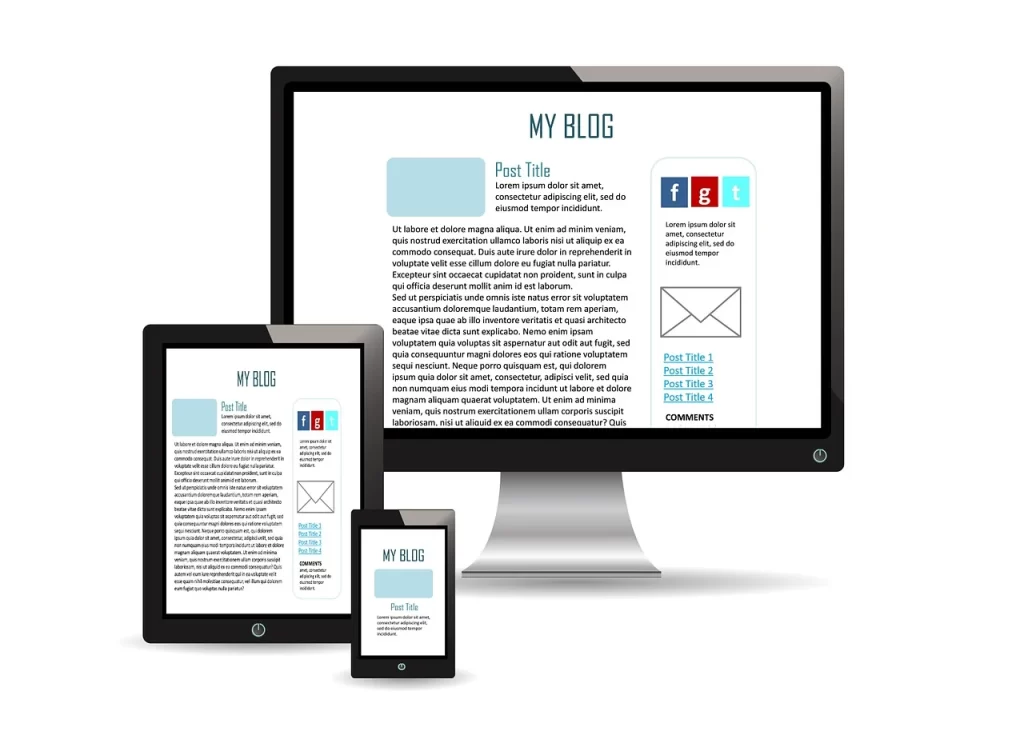Why Add Images to Your Blog?
Let’s talk effective use of images. Grab a copy of the White Pages off your shelf – if you still own one! – and flip open to any page.
Where does your eye go first? Are you pulled into the content? Do you want to read more, or are you tempted to simply slam the book shut and stick it back on the bookshelf?
When visitors come to your website, you have a choice. You can make it inviting and pleasant, or you can make it just about as appealing as the innards of the phone book. The only difference? Effective use of images.
Images – photos, illustrations, or other graphics — are often the first thing visitors look at. If the image is compelling, visitors stay to check out the text. If the image is poor quality or unappealing – or non-existent! – visitors leave. It’s really that simple.
Here are some ways effective use of images enhances your blog:
- They break up text. Facing a page of black-and-white text is daunting. Images can give the eye a place to rest, breaking up the flow of an otherwise monotonous page.
- They lead into the text. Since people look at them first, the images provide a starting point for the rest of the blog post. Good images are like flashing arrows that say, “START HERE.”
- They introduce the topic. Picking an appropriate, related image gives the reader an idea of what to expect from the post. For instance, a photo of a street sign that says “Bumpy Road Ahead” lets the reader know that the post is about challenges or change.
- They support the post content. A diagram, graphic, or other image can further illustrate the post’s content. A flow chart of a sales funnel, for instance, gives you another way to explain the concepts you’re presenting.
They say a picture is worth a thousand words. If that’s true, you can’t afford NOT to use images in your blog posts. They may be the most powerful tool you have.
Where Do You Get Effective Use of Images for Your Blog?
Now that you’re convinced that images are an important part of each and every blog post, you might be wondering where you get photos and graphics for your posts. There are several places, paid and unpaid, where you can find just about any image you might need:
- Your own photos. The easiest place to find images might be your own camera! Particularly if you write about family-oriented topics such as kids, cooking, crafts, or weight loss, your own photos may be the perfect choice. These days, you can take web-quality photos from inexpensive cameras – and even from your cell phone. The positive: You get exactly what you want. The negative: Sometimes you just want to get the blog post done, not take time for a photo shoot.
- Flickr. Flickr.com is home to millions of images from all over the world. You can search by topic or by photographer. To stay on the right side of copyright law, search Flickr’s creative commons database which includes images that photographers are making available for use. Check out the guidelines at www.flickr.com/creativecommons for full information on the rights photographers are retaining and the usage requirements.
- Stock.XCHNG. Stock.XCHNG (www.scx.hu) is a free stock photo site. Create an account and use one of their 400,000 images on your blog. Stock.XCHNG is a little more limited than Flickr, but generally high quality.
- IstockPhoto.com. A large collection of professional and business quality images and illustrations are available from iStockPhoto.com. The drawback is that it is a paid service that works on credits. You can purchase plans starting with 10 downloads a month at $39 CAD.
- Clipart.com. For the widest variety of images (illustrations, photos, animations, and more), check out Clipart.com. Over 10 million files, all high-quality. It’s also a paid service with subscriptions starting at $12.95 for a week of unlimited downloads and topping out at $99.95 for one year single user license.
If you’ve looked through the above choices and still can’t find something you like for effective use of images, there are numerous other options. Just google “copyright free images” and you’ll have more options than you can ever use.

Incorporating Images into Your Post
Adding your selected images to your blog posts is as easy as following these steps:
- Save your desired image to your desktop in a usable format — .jpg, .gif, or .tif are usually supported, but refer to your blogging platform’s guidelines for more information.
- Resize the image. You don’t want a huge image that overtakes the whole post, and you also don’t want an image that is so small that it’s hard to see. Ideal size will depend on your blog theme, but typically around 300×300 pixels is a safe size. You can resize using a free photo editing program like Irfanview (irfanview.com), or if you are on a Mac you can do it right from the preview screen.
- Save as a smaller, lower-quality file. No one wants to wait several seconds for your blog page to load (hint: It’s usually the graphics that slow things down!). To rectify this problem, save your image as a smaller file. The higher the resolution, the larger the file and the slower the upload. 72dpi is perfect quality for a web page and loads very quickly. Again, Irfanview or your Mac preview will let you change the file quality.
- Upload to your blog post. You used to have to use an intermediary hosting site to add your images to your blog – no more! Most blog platforms (certainly Blogger, Typepad, and WordPress) enable direct uploading of your images. Just click on the “add image” button, browse to select, and away you go. Many programs will let you resize and place the image once it’s added to your blog post.
- Add caption and copyright info. If you’ve used a photo from Flickr’s creative commons database or any other image with creative commons license restrictions, you’ll need to provide attribution. On WordPress, you can create a caption that includes the photographer’s name and copyright info. On other blogging platforms, you may need to place a note in the blog text with that information.
There you have it; a simple, five-step process to jazzing up your blog posts quickly and easily with the effective use of images of your choice.
Optimizing Images for SEO
Savvy bloggers know to take every opportunity to increase their appeal to search engines. Why should you care? Because every time your blog or blog post comes up in the search engine results, you have the opportunity to drive additional traffic to your blog… and that means more readers and, if you are selling something, more customers!
Here are some easy ways to use the images you place on your blog for SEO (search engine optimization) purposes:
- Optimize the file name. Your camera may automatically generate an image file name like “234455.jpg.” The search engines have no idea what to do with that! Instead, before uploading to your blog, rename the file to something distinguishable like “easy-pumpkin-pie.jpg.” Make the title descriptive with a few of your keywords, but don’t go overboard with a fifteen-word title.
- Use the alt attribute. Search engines use the alt attribute field to help determine the content of the image; if the alt field is empty, the engines don’t always know how to interpret the image. If you’re using WordPress, it’s simple to change the alt information. Upload your image using the “Add Image” function, and then in the “Alternative Text” field, add your alt text info, again using your descriptive keywords.
- Use the title attribute. The title is what shows up when your cursor hovers over the image. Fill in the information for the title just as you would the alt attribute, using the same method from the “Add Image” function on WordPress.
- Use your keywords in your post. It seems obvious that you’d want to use your keywords in your text, but some bloggers forget, thinking it’s enough to mention them in the title and/or the attributes above. Not so! If your blog post is about how to make home décor items from dryer lint, then you should mention that phrase several times in the text of your blog post, and illustrate the post with a photo of revamped dryer lint. The file name of the photo, as well as the alt and title attributes, should all support that keyword phrase.
SEO is mostly common sense. Think about what people would type into Google or their favorite search engine to lead them to your blog post. Then use that phrase wherever you can – without overdoing it.
Avoiding Mistakes with Effective Use of Images
Just like everything else online, effective use of images in your blog posts is fairly easy, but it’s also easy to make a mistake. Here are some of the most common image-related mistakes and how to avoid them:
- Not using an image. It’s better to use a generic image than no image at all if you can’t find the specific photo or graphic you want. Even if the image doesn’t directly support the text of the blog post, it still provides the benefits of breaking up text and pulling people in.
- Using goofy clip art. We used to see stick people all over PowerPoint presentations and in corporate newsletters in the early days of the web. With the wide variety of high-quality graphics available online for free, there’s no excuse for using 1990s-era clip art. It makes you look unprofessional, not retro.
- Using unrelated images. If I see one more sidebar ad with a bikini-clad woman and the words “Moms to go back to school,” I am going to scream! Sure, people may look because there’s a good looking babe, but using unrelated graphics to pull people in is rude. They won’t stick around once they know they’ve been misled.
- Not resizing the image. While images can make your blog looked polished and professional, having images that hang over into the margins or that are cut off is sloppy blogging. Use a free software program (Irfanview.com is great) or, if you’re on a Mac, your preview tool, to resize the image to the right proportions.
- Stealing someone else’s images. There are so many places that you can get non-copyrighted images, there’s no excuse for stealing someone’s copyrighted work. Many photographers and illustrators rely on their work for their livelihood; don’t get yourself in hot water (or bad karma!) by usurping their stuff.
- Using too many images. Yes, it is possible to overdo it on the photos and illustrations. Make sure each graphic you use adds to the quality of the overall blog post. If you don’t need it, don’t use it.
- Using images your audience cannot relate to. Just as the bikini woman is probably not a great draw when trying to reach middle-aged moms, you can easily miss the mark with graphics and photos if you don’t know who you’re writing for. This is where knowledge of your market is critical; know what they want, and give it to them.
If you’re worried about using images properly, just start slow. Begin by using your own photos so you don’t have to worry about copyright issues, and practice resizing, uploading, and tagging. You’ll soon be ready to take on bigger challenges, and your blog will thrive as a result of your efforts.
Want to Learn More About Effective Use of Images?
Want to learn more on effective use of images for your blog? Click here to read “Important Website Design Features“.







